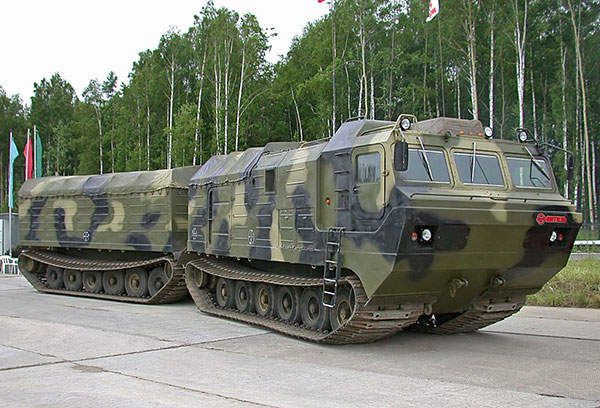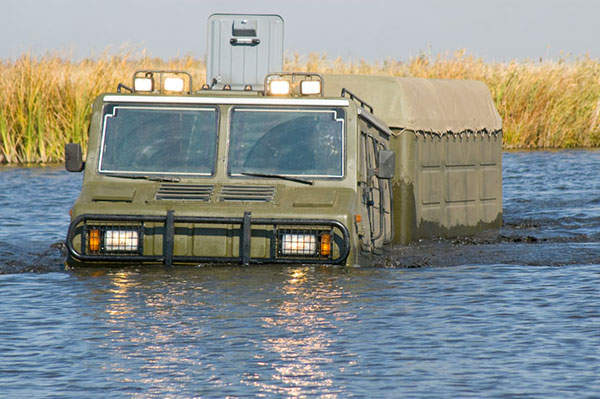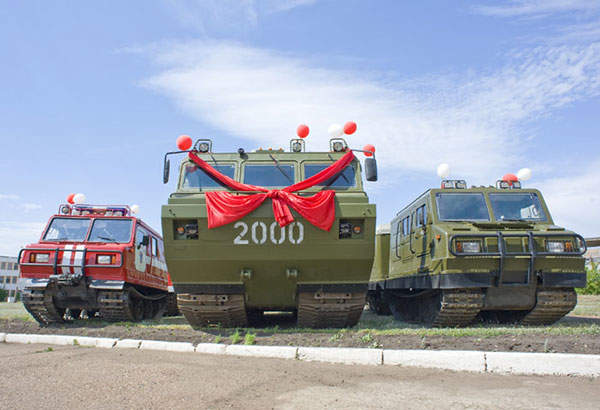DT-30 Vityaz is an articulating tracked vehicle (ATV) manufactured by Ishimbai Transport Machine-Building Plant (Ishimbaitransmash). It is designed to transport heavy loads in extremely difficult off-road conditions such as swamps, sand and snow. In addition to armed forces, the vehicle is also used for civilian applications.
Russia (then USSR) felt the need for such an advanced ATV in early 1960s when existing single-unit tracked snow and swamp-going vehicles were not able to transport payloads in excess of 5t. In order to overcome the problem, a dedicated design bureau was established for the development of ATVs. As a result DT-LP and DT-L, the first two ATVs, were produced for trials by the State in February 1971.
In addition to Russia, these vehicles are heavily used in Arctic and Antarctica. Such vehicles are also in demand in Middle East, Asia, and North and South America.
DT-30 Vityaz ATV development details
The state trials of DT-LP and DT-L (the first ATVs) were carried out in 1971 and the DT-10P, DT-20P and DT-20 ATVs entered the Russian Army’s service in 1980. The first batch of the DT-10P ATVs, manufactured by Ishimbai Transport Machine-Building Plant), came out in 1982. Trials of the twin-unit ATVs DT-30P and DT-30 were completed in late 1981.
An intensive research and development programme for the creation of twin-unit Vityaz family comprising the DT-10, DT-20 and DT-30 variants was completed by 1985.
Variants of DT-30 ATV
The DT-30, with a single flat-bed cargo body, is the original vehicle in the series. Due to its high load and bale capacities, the vehicle could be used in unfriendly road and climatic conditions.
The DT-30P Vityaz is a twin-unit ATV with two load carrying areas and has been in production since 1986. The greatest benefit of this vehicle is its effective use in search and rescue operations carried out in rough conditions such as those in natural disasters. It plays a key role in evacuating people and animals from affected regions and in supplying rescue parties with equipment and food.
The DT-30PM is an improved version of DT-30P. Equipped with electro-hydraulic system for turn operation, the vehicle can get over water hindrance without special preparation.
With a payload capacity of 10t, the DT-10P Vityaz is a smaller articulated tracked carrier. The DT-10PM Vezdesusciy is an improved version of the DT-10P.
Russian soldiers positioned in rough environmental regions widely use DT-10P and DT-30P variants to carry army elements, ammunition and equipment, and install weapon systems. These vehicles also play a significant role during search and rescue operations carried out in extreme climatic and road conditions.
Design of DT-30 articulated tracked vehicle
The DT-30 vehicle has a length of 16.08m and width of 3.1m. It also has a track width of 2m and minimum turning radius of 17.3m.
The various segments of the DT-30 vehicle are held together by joints. The payload capacity as well as the weight of the vehicle is 30t. Seating for driver and four passengers is provided in a forward control cab, which is fully enclosed.
The power plant is arranged in the first unit behind the cab, while the rear unit can be used for storage.
The vehicle’s four rubber band tracks are reinforced with welded steel cross-pieces. Sprockets with nine pairs of polyurethane rollers and road wheels with rubber bands are driven by four track guide engagement. The vehicle is provided with an independent torsion-bar suspension with spring supports on all rollers.
Large surface contact with the ground for better stability is achieved by an unconventional pattern of four active track envelopes.
Engine and performance
The vehicle is powered by a V-shaped, 12-cylinder multi-fuel diesel engine. This four-stroke engine, generating 710hp, was developed from those used on the T-64 main battle tank. A pre-heater facilitates the start of the engine at temperatures as low as -50°C.
The engine has a rotational speed of 2,000rpm and stock torque of 18%. Specific fuel consumption is 245g/kWh. The minimum temperature for reliable starting is 5°C. Ambient temperature at which the engine can be started ranges from -40°C to +50°C.
The ATV moves at a speed of 45km/h on road and 5km/h afloat. It cruises at a range of 700m and can negotiate grade of 32°.






